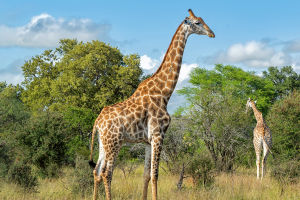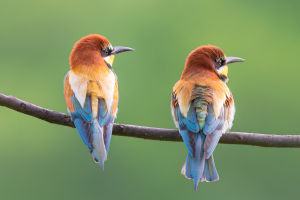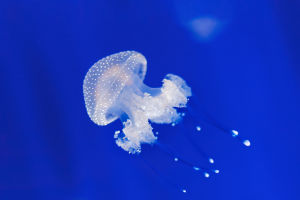The Tallest Land Dwellers
Giraffes are herbivorous mammals endemic to Africa, renowned for their long necks and graceful posture.
As the tallest animals on land, adult male giraffes can reach heights of 5.5 to 6 meters, while females are slightly shorter, typically ranging from 4.5 to 5 meters in height.
This unique and towering appearance makes them stand out on the African savannah, easily identifiable against the backdrop of their environment.
Despite the giraffe's neck being up to 1.8 meters long, it remains well-proportioned to their body. Interestingly, their long necks do not result from an increased number of cervical vertebrae. Like most mammals, giraffes have seven cervical vertebrae, but these are greatly elongated.
This distinctive body structure allows them to access food high up in the trees, particularly favoring the tender leaves of acacia trees. Their towering height grants them access to food sources that are out of reach for most other animals, providing them with a distinct advantage in the competition for nourishment on the savannah.
In addition to their necks, giraffes possess exceptionally long tongues, which can extend up to 45 cm. Their tongues are both flexible and dark purple. The dark pigmentation of their tongues helps to prevent sunburn, as giraffes spend a great deal of time each day foraging under the hot African sun.
Their long, prehensile tongues allow them to skillfully wrap around branches and strip leaves off trees, all while avoiding injury from the thorny plants they often eat.
Giraffes have a diverse diet, primarily consisting of leaves, particularly those with high water content. This adaptation helps them maintain their water balance during the dry season, when water sources may be scarce.
Giraffes are equipped with sharp senses, including excellent vision, a keen sense of smell, and acute hearing. These heightened senses enable them to detect potential threats from predators such as lions.
Despite their large size, giraffes are not immune to danger, especially the younger ones, who are more vulnerable to attacks by predators. Adult giraffes, however, have developed effective methods of defense.
Their powerful hind legs are capable of delivering fatal kicks to predators, making them formidable opponents when they feel threatened. Nonetheless, their primary means of defense remain their height and alertness. Giraffes rely on their ability to spot potential threats from a distance and flee quickly when necessary.
The social behavior of giraffes is both fascinating and unique. They typically live in groups, though the size of these groups is variable. A giraffe group can consist of a small number of individuals or as many as 20 or more.
There is no fixed leader within these groups, and the relationships between members are relatively loose. Their interactions are largely centered around foraging and reproduction.
Female giraffes are usually responsible for the care and nurturing of the young in the group, while males engage in fierce competition during the breeding season.
One of the most notable behaviors of male giraffes is "neck fighting," in which they swing their necks at each other to establish dominance and secure mating rights. This behavior helps determine which male will take the dominant position in the group.
Giraffes have a lengthy breeding cycle, with a gestation period of approximately 15 months. Typically, only one calf is born at a time. Newborn giraffes are already quite tall, standing around 1.8 meters at birth, and they can stand and follow their mothers shortly after birth.
This ability is critical to their survival in the wild, as young giraffes are particularly vulnerable to predators. Giraffe calves grow rapidly, staying close to their mothers for the first few months of life before gradually adapting to a more independent existence.
Despite the seemingly peaceful lives, giraffes lead on the African savannah, their habitats face increasing threats. Habitat loss, illegal hunting, and climate change all pose significant challenges to giraffe populations.
In recent years, the giraffe population has experienced a sharp decline, with certain subspecies being classified as endangered. Efforts are being made by international organizations and wildlife reserves to protect giraffes, focusing on preserving their natural habitats and combating poaching.
The giraffe's elegance and distinctiveness have not only made them a symbol of the African savannah but have also captured the admiration and affection of people worldwide.
Whether in nature, art, or culture, the giraffe's long neck and towering stature have become an iconic representation of the perfect combination of grace and strength.


